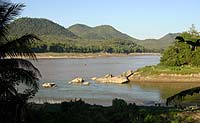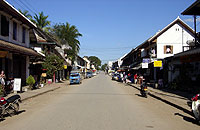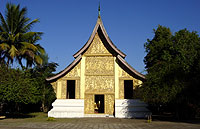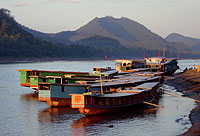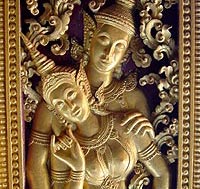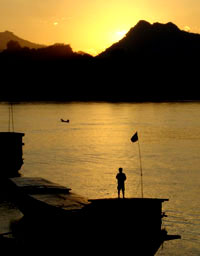Laos' Terrible Legacy
Although officially a neutral country, Laos was host to a secret and terrible war between the USA and Vietnam. As a result, Laos earned the distinction of being the most bombed country in the history of modern warfare.
The Secret War
The war in Laos was so secret that the country's name was never included in
any of the original US records; it was referred to as "the other theater".
Neutral Laos was off limits according to the Geneva agreement. As a workaround, the US sent CIA agents and soldiers in under the guise of civilians; the air raid missions were fought by men in cutoff shorts and cowboy hats.
The Vietnamese didn't bother to disguise their soldiers.
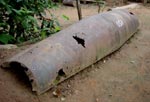 Guerrilla
Armies, Opium Payrolls
Guerrilla
Armies, Opium Payrolls
The USA recruited 60,000 Hmong hill tribe villagers to fight in the war. These
soldiers were paid with special funds earned through CIA-supported opium trafficking.
Staggering Statistics
The USA conducted over 10,000 missions during the nine-year war and dropped
over 1,000,000 bombs. This equated to one ton of explosives dropped for every
man, woman, and child living in Laos at the time.
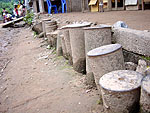 Indiscriminate Bombing
Indiscriminate Bombing
Specific guidelines had to be adhered to during the Vietnam War. Called Rules
of Engagement (ROEs), these guidelines prohibited bombing within a certain distance
of temples and established policies toward civilians. In Laos, the ROEs went
out the window, and both sides were free to bomb whatever – and whoever
– they liked.
Costly Devastation
The secret war in Laos remains the most costly operation ever conducted by
the USA. US taxpayers funded the nine-year war at a cost of $2 million per day!
A Strategic Loss
Despite their superior and plentiful firepower, the US-Hmong forces won few
victories in the nine-year war. They were outnumbered, out of their element,
and under-prepared.
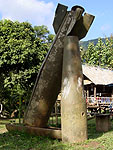 Visible Remnants
Visible Remnants
There are huge swatches of North-Eastern Laos that are still bare from the defoliants
and herbicides used during the war. Parts of the countryside are so dimpled
and scarred from bombs that they resemble a lunar landscape.
There are also a vast number of US bombs and shells lying around the countryside. The industrious Lao people have put many of these shells and casings to good use as landscaping, building materials - even flower pots.
Further Reading
I'm not sensationalizing this history or jumping on any conspiratorial bandwagon.
The secret war is well documented. Nixon admitted to the operations once the
war concluded.
If you'd like to learn more about the secret war, try one of these books:
The Ravens: The Men Who Flew in America's Secret War in Laos by Christopher Robbins
Shadow War : The CIA's Secret War In Laos by Kenneth Conboy
Shooting at the Moon: The Story of America's Clandestine War in Laos by Roger Warner
Laos was a neutral country during the Vietnam War. But that didn�t stop the USA and Vietnam from dropping more than one million bombs on it.
Three Day Trek in Northern Laos
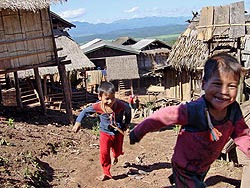 |
kids near Muang Sing |
- played rattan with village children and chewed their sugarcane
- shared a lunch of sticky rice and fish head soup on a tractor trail with field workers
- took a dip in a local swimming hole
- accepted tea and a dinner invitation in an Akha family's hut
I even watched the chief of one village recline on a bed of Chinese cushions and smoke ten pipes of opium.
But communication with the hill tribe people – some of whom don't even speak Lao – was difficult.
I was anxious to learn more about the villagers' way of life, so I headed down to Luang Nam Tha and signed up for a three-day trek led by an experienced guide/translator.
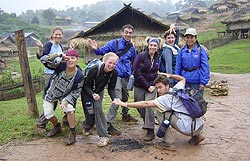 |
cast and crew
|
The trekking organization was a low-impact, eco-friendly outfit sponsored by the government of New Zealand. Our guide was a young, well-spoken local; he was assisted by a middle-aged lady who possessed the strength of four water buffalo.
My fellow trekkers included four Australians, one Canadian, and a fellow American. They were a friendly bunch, with plenty of travel intelligence and good humor to share. Joking about 80's films and the Jackson Five in the middle of a Lao forest preserve was a surreal experience.
A Most Wonderful Time of the Year
December in northern Laos is an ideal time of year. Cool, overcast mornings
give way to bright, sunny afternoons; sunny afternoons dissolve into crisp and
clear evenings. The complete absence of light pollution – or any real pollution at all, for that matter – allows the stars at night to shine big and close and bright.
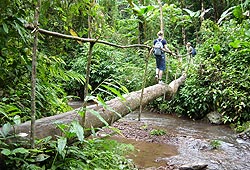 |
river crossing |
Wild banana trees, gigantic ferns, and cascading vines dominated the scenery on the first day of the trek. We climbed dry dirt paths to the top of rolling mountain ranges and descended again into dense jungle valleys crisscrossed with clear and clean rivers. Simple log bridges spanned the larger rivers, putting my grade-school balance beam experience to the test. Too bad we didn't study slippery rock hopping in gym class.
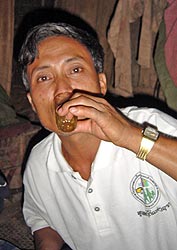 |
Vice Chief enjoyed the occasional
nip of lao-lao |
For each of our village stays we were to be joined by the Chief for dinner. The Chief of the first village was out on business when we arrived, so we were joined by the Vice Chief. He was a short, handsome fellow of 44 who resembled Al Pacino circa Scarface. He came bearing a liter of Lao Lao, which is clear-colored, village-brewed whiskey that tastes like grain alcohol and kicks like diesel fuel.
We sat cross-legged on the floor around low tables and feasted on heaps of sticky rice, pumpkin curry, and eggplant dip. Shots of Lao Lao circulated throughout the meal; the Vice Chief howled with laughter as we gasped for breath after each shot.
Q & A
Well-satiated from the meal and well-lubricated from the Lao Lao, we engaged
in a lengthy question and answer session with the Vice Chief. Through our guide/interpreter, the Vice Chief told us about the village's marriage customs (18 and over is the preferred age, although this is flexible), religious beliefs (animism), and funeral ceremony (deceased are placed into a wooden boat and buried; a celebration follows).
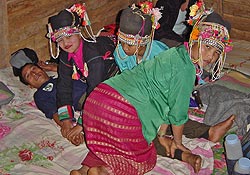 |
the girls gave Vice Chief
a triple-team speed massage |
A parade of village girls piled into our hut as the Q&A winded down. "Who wants a massage?" the Vice Chief asked. Surprised and delighted, we all crawled over to our thin mattresses and allowed the girls to knead our backs with spine-snapping intensity, karate-chop our legs, and give all of our digits a good cracking. Cries of pleasure, pain, and comedy filled the room. The Vice Chief presided over it all, and once our massages concluded he flung himself down on a mattress and had the girls gave him a triple-team speed massage.
A Soggy Second Day
A slate grey sky greeted us on the second day, and grew darker as we hit the
trail. By lunchtime it was raining steadily, transforming the moderate trail
hike into a treacherous muddy Slip-n-Slide. Olympic-style, my fellow trekkers
and I judged each others' tumbles and recoveries. Australia won the gold.
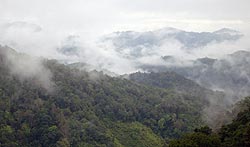 |
misty mountains |
The second evening began similarly to the first, except this time the real Chief joined us. We had another feast, more lethal Lao Lao, and another comedy massage from the village girls.
After the massage the Chief invited us over to his hut, where a party was taking place. Because the rain had prevented the villagers from collecting food that day, they had slaughtered a pig and were holding a feast.
We entered the Chief's spacious, modest hut and sat around a low table that was crowded with roasted pork and various spices. The pork was stunningly delicious – crispy on the outside, tender and tangy on the inside; a dip of chili powder elevated the pork to Utopian heights.
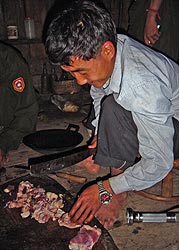 |
pork preparation |
We dispensed with the pork – and several more shots of Lao Lao – in record time and were hungry for more, so we negotiated a deal with the Chief: sell us more pork and we'll share it with everyone in the hut.
Our pooled funds of $3 bought us two kilos of pork. One of the men sliced up the meat while others diced garlic and chilies. The whole lot was fried in a wok atop an open fire. We sat and waited and whetted our appetite with Lao Lao.
But no amount of Lao Lao could obscure what was ultimately served to us in gigantic ceramic bowls: mounds and mounds of steaming, glistening pork fat.
To be fair, there was a bit of pork liver and skin in there too.
Mining through a bowl of pork fat with chopsticks in search of stray bits of meat is no easy task, and we quickly abandoned the pursuit. But the villagers tucked in with abandon. The Chief attacked the fried fat with particular relish.
Our abstinence went unnoticed as the men around us hungrily consumed several weeks' worth of calories.
Mr. Porkman, Bring Me a Dream
Later that night, as I lay in my bed, an improvised song (sung to the tune of
"Mr. Sandman") ran through my head:
Mr. Porkman, bring me some pig
Make it all fatty and fleshy and big
With glistening cubes and pieces of liver
Oh Mr. Porkman how you make me quiver!
I envisioned a chorus of cabaret girls dancing around a giant Porky Pig figure with a top hat and cane. And I chuckled myself to sleep.
On a three day trek in northern Laos I hiked through pristine forests, drank bootleg whiskey with a village Chief, and attended a big pork party.
Luang Prabang, Laos, "The Best-Preserved City in South East Asia"
|
I don't think I've ever used the word "charming" to describe anything – especially not a city. But Luang Prabang, Laos, demands to be called just that. Charming. Quaint, picturesque, and enchanting too. Two Rivers Converge A Trip Back in Time Real Bread, Real Coffee, Real Cheese: Thank You France! A UNESCO "World Heritage City" Luang Prabang has since been added to UNESCO's World Heritage list, which entitles the city to UN funds for preservation. A team of international and Lao architects now work full-time to restore temples, protect historical sites, and monitor new development. This is good news for the city and its admirers, as World Heritage status guarantees that the city will be forever free of McDonald's restaurants and K-Mart superstores. Ready-Made for Romance The city inspires so much idealized daydreaming that I decided to leave early. It's my favorite city in Asia, but I had to get out of there before it made me too soft. Thanks to UNESCO, though, I can always return under different circumstances and enjoy the city's untainted charm.
|
|
